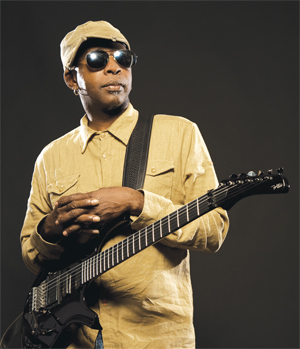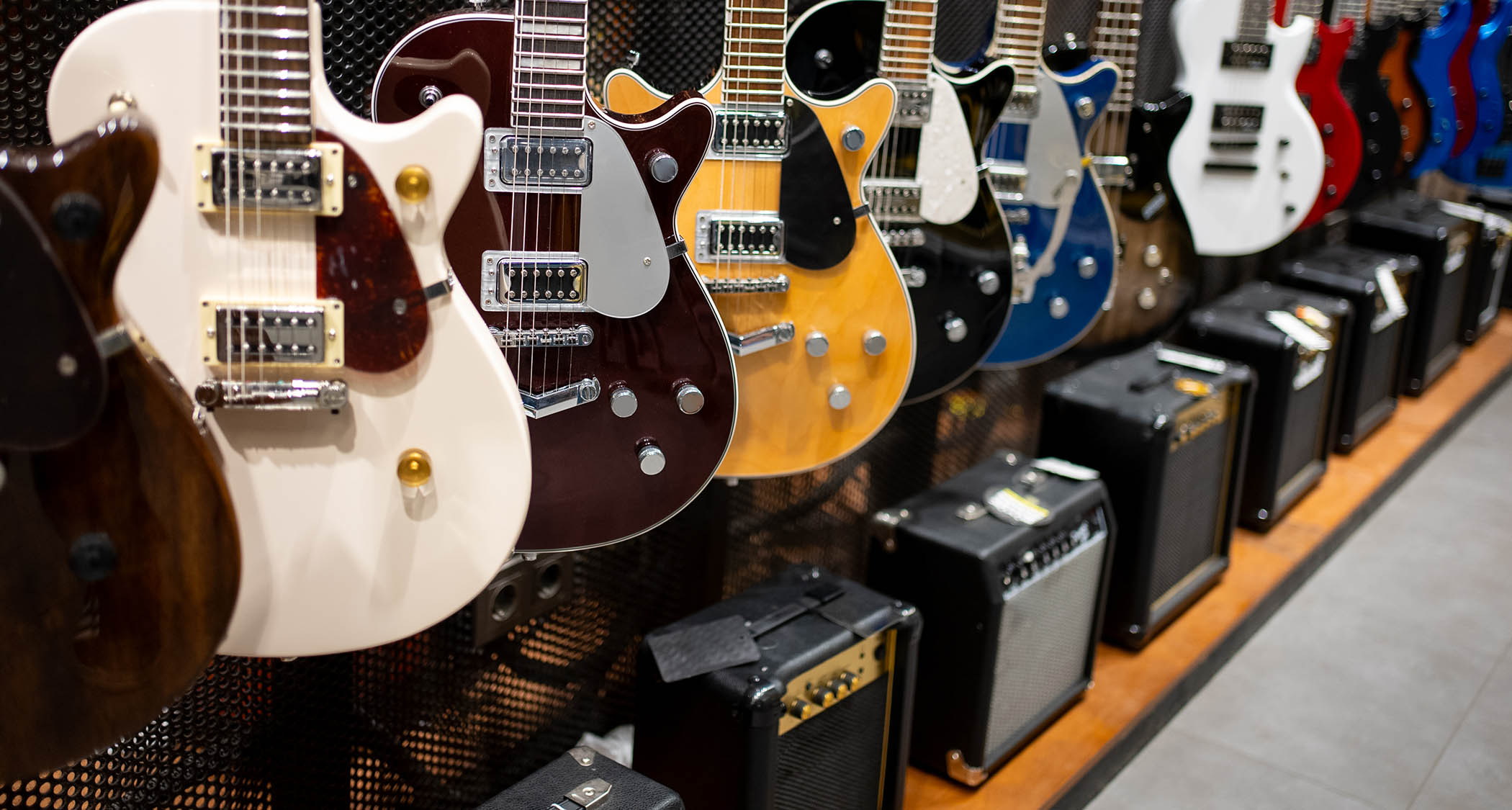Dear Guitar Hero: Vernon Reid

His band was discovered by Mick Jagger, he wrote one of the biggest rock songs in history, and he even founded the Black Rock Coalition. But what Guitar World readers really want to know is…
What led to the writing and recording of “Cult of Personality,” and how do you feel about the fact that the song continues to be a radio staple and is a big part of the Guitar Hero video game franchise? —Moko Nishihara
The writing of “Cult of Personality” was one of the very best days in the life of Living Colour. That might seem obvious, but what I mean to say is, we started the day without “Cult of Personality,” and when that one session was over, we had the song. That day, we didn’t get in our own way. It was a really special day.
I had met the Guitar Hero guys very early on at a NAMM show, and barely anyone was paying attention to them. They showed me how the controller worked. I tried it, I sucked. But I thought, Wow, this is interesting. The next thing you know, Guitar Hero blew up. By the time Guitar Hero III came around, they told me they wanted to include “Cult.” I’m just proud that we are on the same edition of Guitar Hero as the Sex Pistols.
What led to the formation of the Black Rock Coalition in 1985, and what has it become over the past 24 years? —Layne Glover
Back in 1985, I was thinking about what a struggle it was to get any attention in the scene that was going on. At the time, I had formed the band that would become Living Colour; my friend and colleague in the Decoding Society, bassist Melvin Gibbs, had formed a band called Eye & I with vocalist DK Dyson. I was at a gig of a friend of mine, and the club [CBGB] was totally empty. I decided to make a call out to people I knew that had the same taste as me. We all started talking about culture, and about black people in rock music, but it wasn’t limited to that. Part of it was, what does it mean to be black, who decides what “blackness” is, and what does “identity” mean?
For many people, rock music is completely the music of white males. Part of that problem was a matter of classification, because many of the bands that I classify as rock bands are usually classified as funk bands. The Isley Brothers in the Seventies were a rock and roll band that had hit records with prominent lead guitar played by Ernie Isley, like “That Lady” and “Fight the Power,” and to me, that qualifies them as a rock band. In fact, before they did those records, they’d done CSN&Y’s “Ohio” and Jimi Hendrix’s “Machine Gun” on Isley Brothers Live.
All the latest guitar news, interviews, lessons, reviews, deals and more, direct to your inbox!
War is a band that came into the mix backing up [The Animals’] Eric Burdon, but what they brought to the table was absolutely rock and roll. Another great example is Funkadelic and Parliament; you talk about “Maggot Brain” and guitarist Eddie Hazel—this is rock music. But at that time these bands weren’t regarded as rock bands, and there needed to be an expansion of that definition. I’ve never had a musical identity crisis being a rock musician, because I go from the Isley Brothers to Prince to the Bad Brains without a hitch in my mind.
So the Black Rock Coalition started as a conversation, and it remains a community of like-minded characters, and the idea has spread to another generation, vis-à-vis Afro-punk and other new movements in rock. I think of it as an ongoing thing: what should the role of ethnicity be in rock music? At the end of the day, you have to have songs that are worth a damn, and let’s let all comers have an equal opportunity to win or lose.
Regarding the new Living Colour album, The Chair in the Doorway: at what point did you guys start talking about writing a new album together, and what gear did you use on it? —Matt Reeves
The Chair in the Doorway really began with the title, which comes from something our lead singer, Corey Glover, would say whenever he was frustrated. He’d say, “Well, the problem is the chair is in the doorway.” I asked him what that meant, because it was intriguing to me. The recording process started with demos in a small American studio, and we wound up recording the bulk of the record in the Czech Republic.
For gear, I used Bugera and Recto amps, but I made the majority of the record with the Bugeras and some combos. I discovered Bugera amps when we played the Rocklahoma Festival a few years ago. I use a 333XL head with two 4x12 bottoms, as well as a 333XL combo. I incorporate a hex pickup into my sound, so I use a VG99 guitar synth setup, and I also use Guitar Rig 3, plus a Peavey ReValver. I also used an Eventide ModFactor and a PitchFactor, a Pefftronics Rand- O-Matic, a DigiTech Space Station, a Line 6 Filter Modeler, an SP300 to control the VG99, a GI-20 guitar synth, and an Axon 50 interface to control soft synths on an Apple laptop. You can hear the soft synths on the song “Method” on the new album. I used the UVI Workstation to activate eight-bit samples for the noisy/glitchy stuff at the end of that song.
I like to use a combination of new high-tech stuff and the old-fashioned straight-jacked method. On “That’s What You Taught Me,” for example, I played my Hamer straight into a Krank, a Marshall and a vintage Fender Deluxe Reverb.
Tell us about your Parker Dragonfly DF824VR signature guitar: what you like about it, and what was the idea behind it? —Dennis Feck
I became a Parker endorser, and this new record really represents my transition to the signature Parker. I had been relying on a Hamer custom Chaparral sunburst, which I called “the Trout,” but I brought the prototype of the signature Parker with me to the sessions, and I ended up making a full-time switch to the Parker.
I originally met Ken Parker back in the Nineties, and I had an early prototype that I always liked. I like the fact that the neck is slightly wider, which helps to facilitate tapping and some other techniques. The thing that smoothed my transition from Hamer to Parker is that the same luthier that made my Hamers, Terry Atkins, is also the head of production for Parker. He knew my neck profile, because I like a “V”-shaped neck, and he was able to get my neck profile back on track, which I’m so happy about. It’s a very comfortable guitar for me.
During all the years Living Colour was not active, you participated in tons of different projects, such as film scores, producing, solo albums, and so on. Now that LC is back in action, do you plan to curtail your extra-curricular activities? —Clarissa Skye
Yes, somewhat. We do have a touring schedule that’s coming up, and that’s going to be pretty challenging. The other things have to slow down a little bit, because, number one, I’m determined to make this record successful and to do everything I can to make that happen. But I also want to make a new Masque record [Masque features Leon Gruenbaum on keyboards, Hank Schroy on bass and Marlon Browden on drums. The band released the instrumental Known Unknown in 2004 and Other True Self in 2006, both on Favored Nations] and another Yohimbe Brothers record [Reid with DJ Logic; they released Front End Lifter in 2002]. And I definitely want to do more work with the Free Form Funky Freqs [Jamaaladeen Tacuma, bass and G. Calvin Weston, drums].
How did it feel being ranked No. 66 on Rolling Stone magazine’s 100 All Time Greatest Guitarists list? —John Tollet
I love my number, because 66 is an iconic number in rock and roll—like Route 66. I love the fact that it’s palindromic—it’s the same forward and backward. The only thing that would have been better is if I’d gotten another six and my number was 666. That’s the ranking that all guitarists want.
Can you describe the New York music scene you were a part of when Living Colour was getting off the ground? Is it true that Mick Jagger discovered the band at CBGB? —Jamie Deats
To say that the scene Living Colour came out of was vibrant, or electrifying, or exciting, or frustrating, is all an understatement. The Eighties that we were a part of was completely off the rails. That was when I saw Blue Cheer play a set at Danceteria, when I saw Nick Cave’s very first show in America, when I experienced the early days of the band Material [led by avantgarde New York bassist Bill Laswell]… staggering stuff. It was an outstanding time period for music and a great thing to be a part of. CBGB was the primary hub of all of this activity, along with the original Ritz on 11th Street and the original Lone Star Café on Fifth and 13th, with the giant iguana on the roof! Plus, the days of the old Pyramid club… that’s what I knew from working with Janet Jackson. It was a crucible, and I was blessed to be a part of it.
Hilly Kristal, who ran CBGB, was as important to the band as Mick Jagger was, and maybe even more so. Without Hilly, Mick never would have seen us. I had auditioned for Mick to play on his solo album Primitive Cool, and he told me he was going to come through and check out my band, and he did. It was wild.
